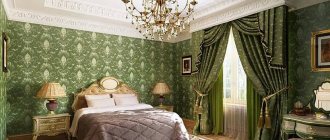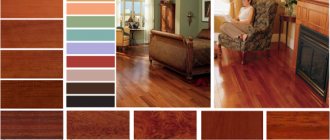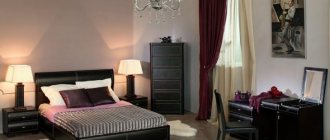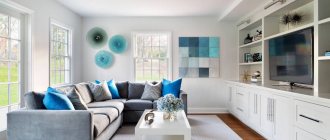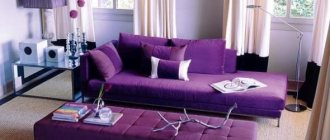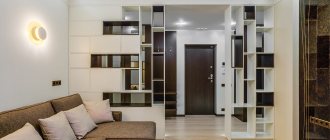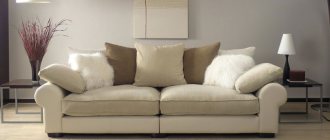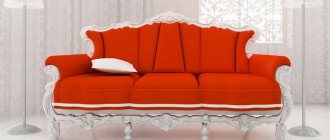The color is a combination of red and blue. There are many shades: purple, lilac, amethyst, plum, which have a relaxing, calming effect on the brain. Violet is a strong color and doesn't lose its character when combined with green, yellow or brown. It tends to absorb light and look too heavy, but if combined correctly with other colors, decor and furniture, it can look elegant, stylish and unusual.
Modern design in purple
Dark purple color in the interior
Beautiful bedroom interior design in purple color
Secrets of the purple world
The psychological effects of the color purple in a stylish designer interior depend on the colors - warm (closer to red) or cold (closer to blue). For example, bluish purple can be calm and relaxing, or mean a manifestation of authority and rudeness. Red will look provocative and cheap, but will calm the nervous system.
By the way, in Catholicism, violet is considered a sign of abstinence, which is why all cardinals wear rings with amethyst. According to psychologists, the presence of this color in the interior of a home is characteristic of artistic individuals and workers in creative professions (artists, musicians, designers). Light shades, such as orchid or heliotrope, have a healing effect on the nervous system: they dull astheno-neurotic syndromes and calm during sudden attacks of panic and fear.
Teenagers who have not yet decided on their profession, tastes and preferences can choose purple as the key color for their room. There is also an opinion that it increases sentimentality and sensitivity, which is why it often becomes the favorite paint of people with unconventional orientation. But most often, purple in the interior is a stimulator of inspiration and creative thinking.
Purple color in the interior
Large kitchen in purple
See also Lilac bedroom
General rules and recommendations
In order to choose the right color for the rooms, you need to correlate several parameters and remember the following rules:
- Violet is divided into warm (lilac, orchid, eggplant and others with a red undertone), cool shades (purple, amethyst, wisteria and others with a blue undertone) and neutral (bright violet and lilac);
- Purple in the interior must be diluted with one or two tones (contrasting or similar, or both);
- In warm shades it makes the room smaller, so it should be used in rooms with windows (preferably two), with high ceilings in white, beige colors and with good lighting;
- In small rooms it is appropriate in details (pouf, painting, table lamp, accent wall), then the room maintains its size and at the same time becomes brighter;
- Purple ceiling and floor cannot be combined;
- You should not use more than four shades of one color tone in the interior of a room.
Purple is appropriate in a living room with good lighting; in the photo, the accent wall and textiles make the room original.
The first purple strokes. How to find your option?
To understand how the color purple can decorate or change the decor of a home beyond recognition, you need to decide what functions the space will perform? For example, for a schoolchild or student’s office and nursery, you need to select calm, subdued options. They should activate thinking and not suppress at the same time. These shades are: prune, mulberry and basil. Lighter colors (light pink, lilac, iris) will incline the nervous system to sleep.
When choosing colors for a bedroom, everything down to the smallest detail should excite (unless the apartment belongs to a single old man), but just enough so that the walls do not “crush.” If the owner or hostess of the room is an eccentric person, then eggplant, dark purple or plum are ideal for them. For calm, patient and sensitive individuals, purple and orchid can transform the bedroom.
The combination of white and purple in the kitchen interior
Chic room design with purple sofa
Purple color in the living room interior
See also: “Mint” color, photo.
General recommendations in combinations
White and black colors are classic, which means they can harmoniously fit into any interior. They will help if it seems that the room is too bright or, on the contrary, gloomy.
Silver and gray paints also look great with purple, but it is advisable to separate the colors from each other with clear boundaries. If blurry, it will give the impression of a dirty color.
Gold, silver, purple... Combination with other colors
In order for the atmosphere in the house to bring only positive emotions, it is necessary to correctly combine tones. You can decorate different rooms using violet as a basis in the following variations.
See also Lavender color in the interior, photo.
Fresh plum
Basic tones: plum, lime green, pale cobalt, snow white. This range will ideally transform a bedroom or living room, the windows of which face the south or south-east. To decorate the space, it is better to use a white or pale pistachio color, while one of the walls can be made a bright accent in the “lime green” option.
Bedroom design in purple
Combination of white and purple colors in the interior
See alsoPurple sofa in the interior
Lavender in the snow
Shades: white linen, snow white, fuchsia, French lavender, eggplant. In this range you can transform the kitchen, dining room and even the children's room. This is one of the most reliable color combinations and is a sign of the Provence style. The walls in such an environment should be painted with creamy white paint or use ecru, pale pink lavender.
See alsoWhite plinth in the interior: photos, tips
Retro cottage
Dominant colors: olive green, pale gold, garnet red, putty, plum and azure. The interior style typical of the 40s of the 20th century can be created in modern conditions, using reddish tones. The walls in this version can be painted cream, pale blue or light gray.
Dark purple color in the interior
Purple color in the interior of the house
Light room design in purple
See alsoCombination of colors in the interior using the color wheel
"Bottle of Claret"
Paints used: dusty turquoise, burgundy, rose sulfur, buttermilk, charcoal and teal (blue green). This combination “cools” the room. The best color for the walls is off-white.
See alsoTerracotta color in the interior: combination with other colors, photo
Magenta
Paints for creating a bright, challenging interior: charcoal, ice blue, mustard, purple, bright olive. To prevent such a design from seeming vulgar, bright “hot” indigo should be complemented with a delicate purple tint. The best options for walls are white, light gray, field mustard.
See alsoWhite laminate in the interior: materials, photos
Picnic by the lake
Shades used: foggy sky, madder rose, bright olive green, fiery orange, dusty plum. The secret of the similarity of the interior with the pretty landscapes of lakes is this: rich shades look harmonious against the backdrop of light neutrals, woody tones and leafy greens. In this style you can decorate a balcony, a spacious loggia or veranda. Current backgrounds are pure white, pale gray, hazy blue.
In addition to remodeling walls, ceilings, floors and doors, purple color in the interior is used for decoration - carpets, curtains, pillows and other accessories. The success of the setting will be ensured by using one paint in three details. For example, walls, pillows and vases.
Room design in dark purple
Bright purple color in the interior of the room
See alsoHigh-tech style apartment: spectacular brevity
Stylistics
Purple color is suitable for bedrooms in various styles:
- Minimalism. This solution welcomes simplicity, laconic forms and soft transitions of shades. This style is an excellent option for decorating small rooms, as the lack of clutter creates a feeling of lightness and additional space.
- Art Deco is a bright style that is associated with chic and bohemianism. Here it is necessary to select details very carefully, since excesses lead to pretentiousness. It will be emphasized by expensive furniture, a combination of purple and gold, and an abundance of luxurious accessories.
- High tech. Metal and the latest technologies are emphasized here. Chrome parts will set off the purple color well. Furniture should not be overloaded with decor, have clear shapes and not stand out from the overall picture.
- Provence. This natural style is characterized by simplicity, deliberate dullness, natural motifs and prints. White, pale pink, green, and yellow shades look harmonious in it.
- The oriental style is characterized by bright palettes, many patterns, gold and silver, an abundance of soft pillows, and a canopy over the bed. To some, this design may seem overloaded and stuffy, so you need to approach its design wisely.
- Eco-friendly. This style uses natural, natural materials. This solution creates a feeling of freshness and expands the space.
Stylish bedroom
To create your dream bedroom, you need to think in advance about the mood it should evoke. Stronger colors, such as eggplant and plum, stimulate the senses and arouse attention. They can be combined with extravagant fabrics - velvet, velor, jacquard. At the other end of the spectrum are more soothing and delicate colors - lilac, lavender, puce. It muffles strong emotions and helps you relax. Using the table, you can determine with utmost precision how the purple color in the interior will set the mood and how other colors will emphasize or subdue its 17 shades.
Table 1. Combining different shades of purple with other colors when creating a bedroom decor.
| How to combine Shade | Perfect | Fine | Badly | ||
| Purple-red | Green, turquoise | Light orange, mint green | Yellow, brown, beige | ||
| Plum | Orange, white | Green, ultramarine | Indigo, light green | ||
| Orchid | Bright crimson, ash | Red | Beige, brown, plum | ||
| Bright purple | Green, blue, brown | Black, ash | White | ||
| Mauve | Silver, beige, terracotta | Orange, crimson, red | Indigo | ||
| Violet | Grey, yellow | Turquoise, | Green, brown | ||
| Eggplant | Black, milky white | Charcoal, pale yellow | Beige | ||
| Amethyst | Turquoise, pale pink | Lemon, red | Crimson | ||
| Heliotrope | Blue, gray, scarlet | Raspberry red, mint color | Fuchsia color | ||
| Indigo | Ultramarine, beige | Brown, white, milky | Dark green, dirty yellow | ||
| Fuchsia | Grey, tan, brown | Lime, mint green, pale yellow | White, black, indigo | ||
| Thistle | Red, yellow, dark blue | Orange, terracotta, fresh greens | Beige, pink, bright purple | ||
| Lilac (lilac) | Yellow orange | Olive, pink | Mocha, lime | ||
| Lavender | Dark brown, | Pale pink, black, mocha | Orange | ||
| Carnation | Black, purple | Light blue, mint | Blueberry, blue | ||
| Magenta (purple) | Light brown, pale yellow | White, scarlet | Beige, ash, charcoal | ||
| Pyusovy | Dark blue, brown | Brown | White, green | ||
Purple color in the interior of the room
Kitchen design in purple
Purple color in the interior
See also Chocolate color in the interior: tips, photos
What colors does it go with?
Lilac is not as versatile as gray or beige. It requires a meticulous approach, especially when it comes to combining it with other tones. The best combinations of lavender and cyclamen shades are obtained if you combine them with the following colors:
- Mustard
Goes well with dark lilac. The pair turns out to be natural, natural, discreet and sophisticated. As other accents, you can add white, add accents with dove and dark purple strokes. A thick, dark blue-green touch will add originality.
- Beige
The color itself is neutral; it is used as a base to reveal all the hidden nuances of another shade. Beige will add elegance and will not overshadow even the lightest shades of lavender.
- Grey
The neutral nature of gray will help highlight the best aspects of lilac. Gray will not strive to come to the fore. Despite the coldish nature of the tandem, it looks elegant, it combines intelligence and a creative note.
- Amber
Brownish-yellow tones fit well into the lilac color scheme of the interior. The warmth, richness and softness of the honey palette harmoniously complements the gentle, but slightly restive character of lilac.
- Turquoise
Interior designers have recently paid attention to this color pair. Interesting stylistic solutions have emerged. The design that combines pastel tones of both colors looks best. You can add a little light brown, light gray colors to them. Bright blackberry or aquamarine accents look good.
- Green
The most natural combination that is found in abundance in nature. Lush foliage of irises, blooming lavender, May bushes of Persian lilac - all this is a small part of the examples of a harmonious duet. But, according to designers, not all green options are suitable for this purpose. For example, too dark colors will make the interior gloomy. The best choice is shades of young greens that have a yellowish undertone. You can dilute the color pair with white, beige or cappuccino.
- Violet
Lilac is a shade of purple. Therefore, their combination always looks harmonious. The monochrome composition turns out stylish. It is suitable for different interior options: art deco, retro styles, modern.
Furniture in the “Violet” version
Cabinets, chairs and seating should be a different color from the walls and flooring. A good combination of eggplant colored furniture would be a black and white room design and silver accents on the walls. Since the purple color fluctuates between blue and red, it can have different colors - warm (purple, eggplant, violet) and cold (indigo, amethyst, lilac). Based on such diversity, you can create a beautiful picture. If the walls in the room are painted in cool shades of purple, then warm colors will help add coziness: lilac, purple, dark purple. Elegant colors such as misty orchid, black tulip and dark lavender can remove the cloyingness of their warm room design.
Table 2. Shades of purple for the interior of different rooms.
| How the Room | Great | Fine | Doesn't fit |
| Living room | Eggplant, amethyst, lavender | Thistle, thistle, clove | Magenta, indigo, violet red |
| Bedroom | Amethyst, plum | Orchid, thistle, carnation, lavender | Pusovy, heliotrope |
| Children's room | Pussy, lavender, mauve | Fuchsia, thistle | Bright purple, plum |
| Kitchen | Fuchsia, indigo | Amethyst, eggplant | Lilac, violet-red |
| Bathroom | Fuchsia, indigo, carnation, magenta | Violet-red, mauve | Clove, lavender |
| Corridor | Thistle, thistle | Indigo, heliotrope | Fuchsia |
| Cabinet | Plum, orchid | Violet | Lilac, purple, magenta, indigo |
Beautiful room design in purple color
Bed in purple
See also: Cozy interior. What should it be like?
Symbolism and psychology of purple color
“Pheasant” belongs to the group of cool and peaceful tones: it does not smell cold like blue, its neighbor in the rainbow, but it is invigorating and refreshing. In Christianity, purple is a symbol of humility; it is not for nothing that the cardinals’ ring is crowned with a large amethyst.
This color is also a sign of nobility. Its ceremonial colors - amaranth, lilac, hyacinth - can be seen in the royal chambers and residences. Shades of purple, psychologists say, do not excite the nervous system, but encourage creativity and inspire. It is believed that their fans are sensitive, inventive people with developed intuition.
Living room and violet
Modern designers divide the color purple into many tones. To make your living room look stylish and modern, purple will help. On walls or framed in decor, it becomes a focal point. In combination with steel gray it becomes elegant, and in tandem with orange it turns the room into a corner of eclecticism. To highlight violet against other colors, use white, beige, black and gray.
The classic combination is dark indigo with gray and charcoal tones. This combination works to the benefit of the space if large parts (for example, a sofa) are aubergine in color, and the rugs next to it are muted gray. Furniture in such an environment can only be light, and textiles are decorated with patterns of lilac and fuchsia tones. Pleasant contrasts in the living room will be created by combinations of lilac with beige and the color of moss green. These colors can be used to decorate walls - you can paint one wall with calm beige, and decorate the other three with lilac.
Bright kitchen in purple
Purple color in interior design
Bedroom design in purple
Interior styles using purple
The first thing that comes to mind is the Gothic style. The sublimity and spirituality of forms will be emphasized in the best possible way by this color. Curtains made of heavy material, sofa cushions, and a carpet in purple tones will reflect the isolation and thoughtfulness of the Gothic style.
Occurrence of this color in:
- panel;
- mosaics;
- stained glass.
will reflect the internal structure of houses of that time. Even the presence of dark combinations will not harm the design. Purple and emerald can be used for decoration or furniture purchases.
The combination of gold and purple against an ivory background will reflect the Greek style. Moderate and enthusiastic, it will be complemented by the eccentricity of the tone in question.
It is better to use purple to reflect the spirit of Greece in:
- floor panels;
- tissues;
- accessories.
Purple in modern styles is perfect for:
- loft;
- high tech.
Represented by lilac shades, Provence will not mind red and blue notes.
They diversify the melody of the room, setting the rhythm. The soft and pliable color will not spoil the overall airy mood. On the contrary, bright accents will add charm to the detailing.
Moderate classics will be diluted with a lightened purple color. It wouldn’t hurt in Empire and Rococo styles. The latter will especially favor this color. The inconsistency of the mixed tone will complement the windy mood of palace sentimentalism.
The complexity of color does not detract from its dignity. Rather, on the contrary, small inclusions from it will add charm to any design. Therefore, you should not be afraid of using a mixture of blue and red, even in the most unexpected variations.
Current bedroom
A room intended for privacy and sleep should bring only positive emotions to a person. For this purpose, purple color and fashionable decor are used. A bedroom in a classic style can be decorated in this way: paint the walls with lilac paint, make the ceiling light, but not white, and cover the floor with laminate of the same light color (for example, linden). Textiles for such a bedroom should be selected from contrasting, dense patterned fabrics. To prevent the decor from seeming too cloying, several pieces of furniture are painted with dark paint.
To create a warm, gentle bedroom, use lighter colors: lilac, lavender, puce. Furniture made of light wood, a classic metal bed with a high headboard and natural fabrics decorated with floral patterns can add even more lightness. Contrasts will add freshness to the atmosphere. For example, blueberry and blackberry tones can be complemented with snow-white, yellow or green colors.
Purple color in the interior
Purple furniture in the living room interior
Adviсe
A purple or lilac bedroom will become a place of relaxation if you follow the rules:
- do not use too dark or bright colors in small rooms;
- use glossy surfaces, they reflect glare and visually increase the space;
- when updating the design in the bedroom, do not stick exclusively to purple shades;
- wallpaper with thin stripes on a white background should only be used for low ceilings;
- if there is gold in the interior, choose furniture in an antique style;
- use purple background for contrasting patterns.
Violet and kitchen
Decorating your kitchen can improve your appetite, lift your mood and inspire culinary experiments. Rich purple can be used to create a dramatic yet functional interior.
The most successful combinations:
- lilac and purple on the walls - gray, white, pink and black in the decor;
- green or pale yellow walls and plum countertops;
- light lilac walls, dark floor and fuchsia furniture.
Lilac glossy walls with light wooden furniture and steel decor will look harmonious.
Fashion trends 2021
The vector of design solutions in 2021 is directed towards minimalism and environmental friendliness. These styles are at the forefront. Today, overloaded with details, a cluttered interior is considered tasteless and heavy.
Space, freshness and getting rid of everything superfluous are glorified. It is advisable to use natural materials, laconic furniture and pure colors in the decoration.
Decorating a bedroom with purple is no easy task. After all, in this room the processes of recuperation and relaxation take place. Therefore, it is advisable to select the tone and style in the room in accordance with character and taste.
How to decorate the walls and ceiling?
Taking into account whether the colors belong to warm or cold shades, you can visually expand the space. Tricks for painting walls will help with this: for example, using plum as a base, you can decorate one wall with a lighter berry tone, and the opposite wall with a darker one. You can connect the space with a light pink tone. The ceiling in the interior of a bedroom, living room or nursery cannot be dark (eggplant, violet-red). When remodeling such rooms, you need to be careful - use mauve, wisteria and heliotrope to paint the ceiling.
Rules and ideas for decorating a living room in lilac color
Lilac shades can make the interior airy, feminine and romantic, or strict, serious, masculine. You can decorate a nursery, kitchen, bedroom, hallway and even a bathroom in this color. The main thing is to skillfully select the tone, be able to beat them and follow the rules for using lilac color:
- Maintain balance. It is important to maintain the ratio of light and dark tones. For example, if the walls are light, then the furniture should be in rich colors, otherwise it will blend in with the surroundings. And, conversely, it is better to select furniture and textiles in light shades for dark walls. Textiles must be made in diluted colors.
- Monitor the temperature. Any color has warm and cool shades. Lilac is no exception. In the interior you need to correctly combine warm and cold tones. If they are not balanced, the living room will turn out to be too “cooled” or “overheated”. The rule is simple: the main color is cold, which means you need to add a warm tone to it. If the basic solution is warm, then it is diluted with cold nuances.
- Choose the perfect color combination. As already mentioned, the ideal pair for lilac would be: the color of natural wood, olive, grass green, beige, gray, khaki, powder pink. It is advisable to choose pastel shades of these colors.
Design of main surfaces
- The living room facing south should be decorated with cooler lavender shades. To enhance the feeling of coolness, you can add tones of blue and cyan. The heat in summer will not be felt so much.
- It is easy to visually “warm” a hall with access to the north. To do this, just add a pink tone from a warm range to the main color.
- Enlarge a small room with light shades. To do this, the walls and ceiling are painted light lilac. Moreover, the ceiling should be 1–2 shades lighter. This way it will become visually taller, and the room will acquire volume and airiness.
- By mixing other colors with lilac, you can achieve interesting visual effects. For example, if you add dark lilac, violet, and blackberry accents, the design will turn out to be sophisticated and solemn. By adding light blue tones, you can create a feeling of palace luxury or glamor. And the gray color will give the lilac room an eclectic feel.
The living room can be completely covered with lilac wallpaper. In this case, it is advisable to highlight some area in the room with a deeper shade, and decorate the rest of the space in light colors. But it’s better not to make the renovation completely monochrome. The living room will look much more impressive if you add other shades to the lilac. The easiest way is to include beige or gray in the design.
Furniture
Lilac is not the most common interior design option. The choice of this color speaks of the originality of the owner of the house and his creative streak. When choosing furniture for a room, it is important to create a game of contrasts: if the walls are light, then furniture in deep tones will suit them and, conversely, a dark room should be furnished with light furniture. You can choose lilac pillows for a beige sofa. This combination will be especially successful if you hang curtains in purple shades on the windows.
Textiles and carpets
Textiles can be dark or light, it all depends on the basic tone of the room. You can complement lilac curtains with transparent, weightless tulle in a white or milky shade. But it is better to avoid too dark purple shades of curtains. They will create a feeling of heaviness.
There are several options for choosing a carpet in a lilac room:
- Tone on tone. The carpet completely matches the main shade of the room's furnishings. The result is a calm, harmonious interior.
- Contrast. The carpet stands out noticeably against the general background. This option is especially relevant if the living room needs to be divided into zones by color. Often this need arises in one-room apartments or studios.
- To match the color of the vertical. We are talking about when the shade of the carpet is matched to the color of the curtains and/or walls.
- Under color spots. If the room already has color accents, then you can match the tone of the carpet with them. For example, match an orange floor lamp and panel with an orange rug. And in the general atmosphere, lavender color will predominate.
The color of the carpet may well become an independent color accent in the room. But if you still get the feeling that it stands out from the overall picture, then it can always be supported by details of the same color.
Decor and accessories
The decor is selected depending on the style of the living room. But it is necessary to remember that lavender shades combine well with complex draperies, gloss, glass, crystal, metal texture, gilding, elegant figurines, and candlesticks. It is not advisable to combine the shade with rough wood, leather texture and stone.
Lighting Features
Lilac shades get along well with both dim and bright lighting. Dimmed light will create a cozy, intimate atmosphere. But it is better to combine it with light shades. If the room has a dark design, then it is more advisable to use brighter lighting.
The choice of lamp depends on the interior style of the lilac room:
- Classic. For a classic style, a crystal chandelier is suitable. Porcelain or ceramic lampshades in the form of flowers, leaves, bowls, a chandelier or a lamp in the form of a candlestick would also be appropriate.
- Provence. In a Provence-style living room, modest but elegant lamps should be laconic, without monograms or curlicues. Naturalness and simplicity are the main features of this style.
- Modern. Natural lighting is important in modernity. Large windows with plenty of daylight are not uncommon. Artificial lighting is represented by simple lamps in a forged frame, pendant lamps, wall sconces, and floor lamps. The only condition is that they must be simple, without elaborate elements.
- Ethno. Table lamps and floor lamps made of rattan, forged ceiling lamps, lamps with Turkish-style mosaics, and carved torch lamps are best suited for ethnic style.
- High tech. Almost complete absence of decor, laconic geometric shapes in the style of constructivism and cubism, shiny chrome, glossy surfaces with a cold metallic sheen - this is what high-tech style lamps should be.
- Art Deco. Lighting in a lilac Art Deco room should come from above. Floor lamps and sconces can only be used as additional light sources. The most win-win option is a pretentious chandelier with luxurious decor: gilded plates, horns, crystal balls.
The lilac living room always attracts attention with its originality. It stands out from standard concepts about the interior of a living room, and thereby becomes unique, unlike the others. If you prefer non-trivial solutions, then a lilac living room is the best way to show your individuality.
